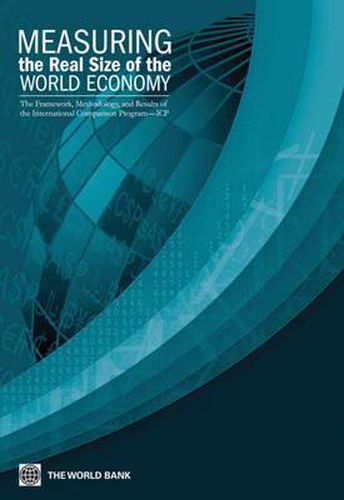Readings Newsletter
Become a Readings Member to make your shopping experience even easier.
Sign in or sign up for free!
You’re not far away from qualifying for FREE standard shipping within Australia
You’ve qualified for FREE standard shipping within Australia
The cart is loading…






The International Comparison Program (ICP) is a global statistical initiative to collect comparative price data to estimate Purchasing Power Parities (PPPs) of the currencies of the world’s economies. PPPs are a form of exchange rate between currencies that is based on price comparisons for every country with more than 1,000 goods and services. The ICP has become not only the largest international statistical program in the world, but also the most complex. The first coordinated attempt to produce purchasing power parities was carried out from 1967 to 1970 and was based on 10 countries. In the years leading up to 2005, six rounds of the ICP were conducted, each with more countries and improved methodology, with the 2005 ICP including 146 countries. The lessons learned from previous ICP rounds led to the development of several significantly new and improved methods for the 2005 ICP. The subsequent analysis of the 2005 data set the stage for additional improvements to the 2011 ICP.
This volume provides a comprehensive review of the statistical theory and methods underlying the estimation of PPPs and real expenditures, the choices made for the 2005 ICP round, and the lessons learned that led to improvements in the 2011 ICP. Disclosing the theory, concepts, and methods underlying estimates enhances the transparency of the 2011 ICP process. This allows interested stakeholders and users to fully understand the strengths, limitations, and assumptions underlying the estimates. This volume also contains several chapters about uses of the data from the 2005 ICP. These uses are significant because they expand the boundaries of the needs served by the ICP to encompass poverty estimation and analysis of the global economic situation.
Worldwide, no other statistical programme requires so much cooperation among national, regional, and international organisations. The ICP greatly depends on the overwhelming support received from national statistical offices. They assume the effort of and responsibility for providing the prices and other measures underlying all components of the gross domestic product and breaking it down into sub-aggregates.
$9.00 standard shipping within Australia
FREE standard shipping within Australia for orders over $100.00
Express & International shipping calculated at checkout
Stock availability can be subject to change without notice. We recommend calling the shop or contacting our online team to check availability of low stock items. Please see our Shopping Online page for more details.
The International Comparison Program (ICP) is a global statistical initiative to collect comparative price data to estimate Purchasing Power Parities (PPPs) of the currencies of the world’s economies. PPPs are a form of exchange rate between currencies that is based on price comparisons for every country with more than 1,000 goods and services. The ICP has become not only the largest international statistical program in the world, but also the most complex. The first coordinated attempt to produce purchasing power parities was carried out from 1967 to 1970 and was based on 10 countries. In the years leading up to 2005, six rounds of the ICP were conducted, each with more countries and improved methodology, with the 2005 ICP including 146 countries. The lessons learned from previous ICP rounds led to the development of several significantly new and improved methods for the 2005 ICP. The subsequent analysis of the 2005 data set the stage for additional improvements to the 2011 ICP.
This volume provides a comprehensive review of the statistical theory and methods underlying the estimation of PPPs and real expenditures, the choices made for the 2005 ICP round, and the lessons learned that led to improvements in the 2011 ICP. Disclosing the theory, concepts, and methods underlying estimates enhances the transparency of the 2011 ICP process. This allows interested stakeholders and users to fully understand the strengths, limitations, and assumptions underlying the estimates. This volume also contains several chapters about uses of the data from the 2005 ICP. These uses are significant because they expand the boundaries of the needs served by the ICP to encompass poverty estimation and analysis of the global economic situation.
Worldwide, no other statistical programme requires so much cooperation among national, regional, and international organisations. The ICP greatly depends on the overwhelming support received from national statistical offices. They assume the effort of and responsibility for providing the prices and other measures underlying all components of the gross domestic product and breaking it down into sub-aggregates.